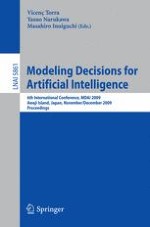2009 | Book
Modeling Decisions for Artificial Intelligence
6th International Conference, MDAI 2009, Awaji Island, Japan, November 30–December 2, 2009. Proceedings
Editors: Vicenç Torra, Yasuo Narukawa, Masahiro Inuiguchi
Publisher: Springer Berlin Heidelberg
Book Series : Lecture Notes in Computer Science
